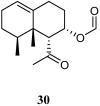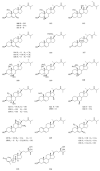Genus Litophyton: A Hidden Treasure Trove of Structurally Unique and Diversely Bioactive Secondary Metabolites
- PMID: 37888458
- PMCID: PMC10608288
- DOI: 10.3390/md21100523
Genus Litophyton: A Hidden Treasure Trove of Structurally Unique and Diversely Bioactive Secondary Metabolites
Abstract
Marine soft corals are prolific sources of various natural products that have served as a wealthy reservoir of diverse chemical scaffolds with potential as new drug leads. The genus Litophyton contains almost 100 species but only a small proportion of them has been chemically investigated, which calls for more attentions from global researchers. In the current work, 175 secondary metabolites have been discussed, drawing from published data spanning almost five decades, up to July 2023. The studied species of the genus Litophyton resided in various tropical and temperate regions and encompassed a broad range of biologically active natural products including terpenes, steroids, nitrogen-containing metabolites, lipids, and other metabolites. A wide spectrum of pharmacological effects of these compounds had been evaluated, such as cytotoxic, antiviral, antibacterial, antifungal, anti-malarial, antifeedant, anti-inflammatory, molluscicidal, PTP1B inhibitory, insect growth inhibitory, and neuroprotective activities. This review aims to offer an up-to-date survey of the literature and provide a comprehensive understanding of the chemical structures, taxonomical distributions, and biological activities of the reported metabolites from the title genus whenever available.
Keywords: Litophyton; bioactivities; cytotoxicity; secondary metabolites; soft coral; terpenes.
Conflict of interest statement
The authors declare no conflict of interest.
Figures











































References
-
- Liu M., Zhang X., Li G. Structural and biological insights into the hot-spot marine natural products reported from 2012 to 2021. Chin. J. Chem. 2022;40:1867–1889. doi: 10.1002/cjoc.202200129. - DOI
Publication types
MeSH terms
Substances
Grants and funding
LinkOut - more resources
Full Text Sources
Molecular Biology Databases
Miscellaneous

